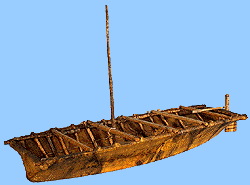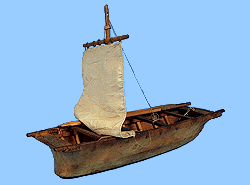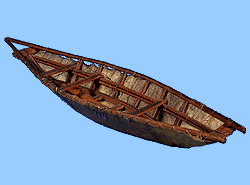 |
Examples of Umiaks
| An umiak is an open boat, with a wooden frame and a covering of bearded seal or walrus hide. Although comparatively light, it could transport up to thirty people and several tonnes of goods. In the Western Arctic it was used for both travelling and hunting and tended to be fairly streamlined. Typical examples were about nine or ten metres long, under two metres wide, and about a metre deep. The bottom was flat, with no keel, and both ends were normally pointed. It could be propelled with either oars and paddles, and was described by European sailors as very fast and manoeuvrable. The umiak was also used in the Eastern Arctic, but almost exclusively as a means of transport. It was the family boat, the "women's boat", in which long summer journeys were made, loaded with weapons and provisions, children, dogs, tents, and clothing. An elder sat in the stern controlling the rudder, while the women rowed, keeping time with songs. Sometimes sails were used, with the mast placed right in the bow. Alongside, the men kept pace in their kayaks. When they landed, the umiak was overturned on the beach and used as a temporary shelter. taken from: David A. Morrison and Georges-Hébert Germain, Inuit: Glimpses of an Arctic Past (Canadian Museum of Civilization, 1995). |
| kayaks | umiaks | bark canoes | dugout canoes exhibition photos | conservation | bibliography | other WWW resources credits |
 |


